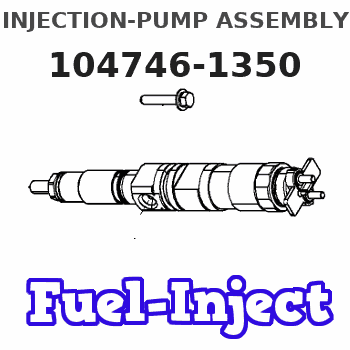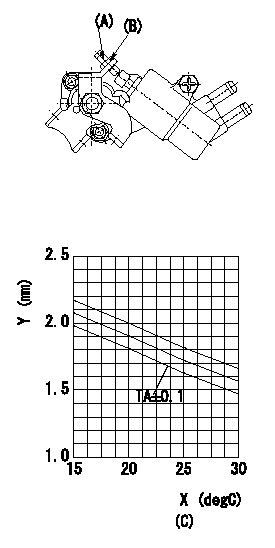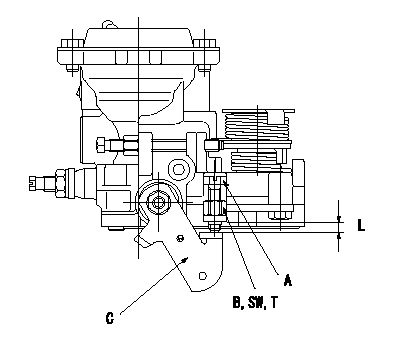Information injection-pump assembly
ZEXEL
104746-1350
1047461350

Rating:
Cross reference number
ZEXEL
104746-1350
1047461350
Zexel num
Bosch num
Firm num
Name
104746-1350
INJECTION-PUMP ASSEMBLY
Calibration Data:
Adjustment conditions
Test oil
1404 Test oil ISO4113orSAEJ967d
1404 Test oil ISO4113orSAEJ967d
Test oil temperature
degC
45
45
50
Nozzle
105780-0060
Bosch type code
NP-DN0SD1510
Nozzle holder
105780-2150
Opening pressure
MPa
13
13
13.3
Opening pressure
kgf/cm2
133
133
136
Injection pipe
157805-7320
Injection pipe
Inside diameter - outside diameter - length (mm) mm 2-6-450
Inside diameter - outside diameter - length (mm) mm 2-6-450
Joint assembly
157641-4720
Tube assembly
157641-4020
Transfer pump pressure
kPa
20
20
20
Transfer pump pressure
kgf/cm2
0.2
0.2
0.2
Direction of rotation (viewed from drive side)
Right R
Right R
Injection timing adjustment
Pump speed
r/min
1000
1000
1000
Boost pressure
kPa
-46.7
-48
-45.4
Boost pressure
mmHg
-350
-360
-340
Average injection quantity
mm3/st.
60.9
60.4
61.4
Difference in delivery
mm3/st.
3.5
Basic
*
Oil temperature
degC
50
48
52
Injection timing adjustment_02
Pump speed
r/min
500
500
500
Boost pressure
kPa
-46.7
-48
-45.4
Boost pressure
mmHg
-350
-360
-340
Average injection quantity
mm3/st.
60
60
60
Oil temperature
degC
48
46
50
Injection timing adjustment_03
Pump speed
r/min
1000
1000
1000
Boost pressure
kPa
-46.7
-48
-45.4
Boost pressure
mmHg
-350
-360
-340
Average injection quantity
mm3/st.
60.9
59.9
61.9
Difference in delivery
mm3/st.
3.5
Basic
*
Oil temperature
degC
50
48
52
Injection timing adjustment_04
Pump speed
r/min
1000
1000
1000
Boost pressure
kPa
0
0
0
Boost pressure
mmHg
0
0
0
Average injection quantity
mm3/st.
46.2
43.2
49.2
Oil temperature
degC
50
48
52
Injection timing adjustment_05
Pump speed
r/min
1440
1440
1440
Boost pressure
kPa
-46.7
-48
-45.4
Boost pressure
mmHg
-350
-360
-340
Average injection quantity
mm3/st.
58.9
58.9
58.9
Oil temperature
degC
50
48
52
Injection timing adjustment_06
Pump speed
r/min
1800
1800
1800
Boost pressure
kPa
-46.7
-48
-45.4
Boost pressure
mmHg
-350
-360
-340
Average injection quantity
mm3/st.
59.2
59.2
59.2
Oil temperature
degC
50
48
52
Injection quantity adjustment
Pump speed
r/min
2100
2100
2100
Boost pressure
kPa
-46.7
-48
-45.4
Boost pressure
mmHg
-350
-360
-340
Average injection quantity
mm3/st.
19.6
16.6
22.6
Difference in delivery
mm3/st.
5.5
Basic
*
Oil temperature
degC
52
50
54
Injection quantity adjustment_02
Pump speed
r/min
2300
2300
2300
Boost pressure
kPa
-46.7
-48
-45.4
Boost pressure
mmHg
-350
-360
-340
Average injection quantity
mm3/st.
5
Oil temperature
degC
52
50
54
Injection quantity adjustment_03
Pump speed
r/min
2100
2100
2100
Boost pressure
kPa
-46.7
-48
-45.4
Boost pressure
mmHg
-350
-360
-340
Average injection quantity
mm3/st.
19.6
16.6
22.6
Difference in delivery
mm3/st.
5.5
Oil temperature
degC
52
50
54
Governor adjustment
Pump speed
r/min
360
360
360
Boost pressure
kPa
-46.7
-48
-45.4
Boost pressure
mmHg
-350
-360
-340
Average injection quantity
mm3/st.
13.2
11.2
15.2
Difference in delivery
mm3/st.
2
Basic
*
Oil temperature
degC
48
46
50
Governor adjustment_02
Pump speed
r/min
360
360
360
Boost pressure
kPa
-46.7
-48
-45.4
Boost pressure
mmHg
-350
-360
-340
Average injection quantity
mm3/st.
13.2
11.2
15.2
Difference in delivery
mm3/st.
2
Oil temperature
degC
48
46
50
Timer adjustment
Pump speed
r/min
100
100
100
Boost pressure
kPa
0
0
0
Boost pressure
mmHg
0
0
0
Average injection quantity
mm3/st.
74
69
79
Basic
*
Oil temperature
degC
48
46
50
Remarks
Full
Full
Timer adjustment_02
Pump speed
r/min
100
100
100
Boost pressure
kPa
0
0
0
Boost pressure
mmHg
0
0
0
Average injection quantity
mm3/st.
74
69
79
Oil temperature
degC
48
46
50
Speed control lever angle
Pump speed
r/min
360
360
360
Boost pressure
kPa
-46.7
-48
-45.4
Boost pressure
mmHg
-350
-360
-340
Average injection quantity
mm3/st.
0
0
0
Oil temperature
degC
48
46
50
Remarks
Magnet OFF at idling position
Magnet OFF at idling position
0000000901
Pump speed
r/min
1000
1000
1000
Boost pressure
kPa
-46.7
-48
-45.4
Boost pressure
mmHg
-350
-360
-340
Overflow quantity with S/T ON
cm3/min
680
550
810
Oil temperature
degC
50
48
52
Stop lever angle
Pump speed
r/min
1000
1000
1000
Boost pressure
kPa
-46.7
-48
-45.4
Boost pressure
mmHg
-350
-360
-340
Pressure
kPa
422
393
451
Pressure
kgf/cm2
4.3
4
4.6
Basic
*
Oil temperature
degC
50
48
52
Stop lever angle_02
Pump speed
r/min
1000
1000
1000
Boost pressure
kPa
-46.7
-48
-45.4
Boost pressure
mmHg
-350
-360
-340
Pressure
kPa
422
393
451
Pressure
kgf/cm2
4.3
4
4.6
Basic
*
Oil temperature
degC
50
48
52
0000001101
Pump speed
r/min
1000
1000
1000
Boost pressure
kPa
-46.7
-48
-45.4
Boost pressure
mmHg
-350
-360
-340
Timer stroke
mm
2.5
2.3
2.7
Basic
*
Oil temperature
degC
50
48
52
_02
Pump speed
r/min
1700
1700
1700
Boost pressure
kPa
-46.7
-48
-45.4
Boost pressure
mmHg
-350
-360
-340
Timer stroke
mm
5.8
5.5
6.1
Basic
*
Oil temperature
degC
50
48
52
_03
Pump speed
r/min
520
520
520
Boost pressure
kPa
-46.7
-48
-45.4
Boost pressure
mmHg
-350
-360
-340
Timer stroke
mm
0.5
0.1
1.3
Oil temperature
degC
50
48
52
_04
Pump speed
r/min
1000
1000
1000
Boost pressure
kPa
-46.7
-48
-45.4
Boost pressure
mmHg
-350
-360
-340
Timer stroke
mm
2.5
2.3
2.7
Basic
*
Oil temperature
degC
50
48
52
_05
Pump speed
r/min
1440
1440
1440
Boost pressure
kPa
-46.7
-48
-45.4
Boost pressure
mmHg
-350
-360
-340
Timer stroke
mm
3.9
3.6
4.2
Oil temperature
degC
50
48
52
_06
Pump speed
r/min
1700
1700
1700
Boost pressure
kPa
-46.7
-48
-45.4
Boost pressure
mmHg
-350
-360
-340
Timer stroke
mm
5.8
5.4
6.2
Basic
*
Oil temperature
degC
50
48
52
_07
Pump speed
r/min
1950
1950
1950
Boost pressure
kPa
-46.7
-48
-45.4
Boost pressure
mmHg
-350
-360
-340
Timer stroke
mm
7.8
7.5
8.2
Oil temperature
degC
50
48
52
0000001201
Max. applied voltage
V
8
8
8
Test voltage
V
13
12
14
0000001401
Pump speed
r/min
1000
1000
1000
Boost pressure
kPa
-46.7
-48
-45.4
Boost pressure
mmHg
-350
-360
-340
Average injection quantity
mm3/st.
31.8
31.3
32.3
Timer stroke TA
mm
2.2
2.2
2.2
Timer stroke variation dT
mm
0.3
0.1
0.5
Basic
*
Oil temperature
degC
50
48
52
_02
Pump speed
r/min
1000
1000
1000
Boost pressure
kPa
-46.7
-48
-45.4
Boost pressure
mmHg
-350
-360
-340
Average injection quantity
mm3/st.
31.8
30.8
32.8
Timer stroke TA
mm
0.3
-0.1
0.7
Basic
*
Oil temperature
degC
50
48
52
_03
Pump speed
r/min
1000
1000
1000
Boost pressure
kPa
-46.7
-48
-45.4
Boost pressure
mmHg
-350
-360
-340
Average injection quantity
mm3/st.
16.7
15.7
17.7
Timer stroke TA
mm
1
0.4
1.6
Oil temperature
degC
50
48
52
Timing setting
K dimension
mm
3.3
3.2
3.4
KF dimension
mm
5.8
5.7
5.9
MS dimension
mm
0.5
0.4
0.6
Decrease stroke
mm
3
2.8
3.2
Pre-stroke
mm
0.1
0.08
0.12
Control lever angle alpha
deg.
18
14
22
Control lever angle beta
deg.
31
26
36
Test data Ex:
0000001801 W-CSD ADJUSTMENT

Adjustment of the W-CSD
1. Adjustment of the advance angle of the timer
(1)Determine the timer advance angle using the graph.
(2)(1) Adjust with the screw (A) so that the timer advance angle determined in the item (1) is obtained.
Y:Timer stroke TA
X:Temperature t
(C): timer stroke TA(mm)
----------
----------
TA:TA=-0.0345t+2.59
----------
----------
TA:TA=-0.0345t+2.59
0000001901 V-FICD ADJUSTMENT

Adjustment of the V-FICD
1. Insert a shim L1 between the control lever (A) and the idle adjusting screw (B) and adjust using the FICD adjusting screw (C) so that the actuator moves through its full stroke. Then, fix using nut (D).
If adjustment with the FICD adjusting screw (C) is not possible, adjust by moving the actuator stroke with (E) and (F).
2. Apply P1{P2} pressure to the actuator and confirm that the actuator moves through its full stroke. After release, confirm that the gap between control lever (A) and FICD adjusting screw (C) is at least L2.
(G): exceeds L2 when releasing actuator
(H): actuator stroke L3
----------
L1=1.40+-0.1mm L2=0.5mm L3=5mm P1=-53.3kPa P2=-400mmHg
----------
T=3.4~4.9N-m(0.35~0.50kgf-m) L1=1.40+-0.1mm
----------
L1=1.40+-0.1mm L2=0.5mm L3=5mm P1=-53.3kPa P2=-400mmHg
----------
T=3.4~4.9N-m(0.35~0.50kgf-m) L1=1.40+-0.1mm
0000002001 STARTING I/Q ADJUSTMENT

Starting injection quantity adjustment
Adjust adjusting bolt A so that the starting injection quantity is within the standard.
Fix using nut (B).
Screw A protrusion: L
C = stop lever
----------
L=2~8.5mm
----------
L=2~8.5mm T=6~9N-m(0.6~0.9kgf-m) SW=SW10
----------
L=2~8.5mm
----------
L=2~8.5mm T=6~9N-m(0.6~0.9kgf-m) SW=SW10
Information:
Starter Motor
The starter motor is used to turn the engine flywheel fast enough to get the engine to start running.The starter motor has a solenoid. When the start switch is activated, the solenoid will move the starter pinion to engage it with the ring gear on the flywheel of the engine. The starter pinion will engage with the ring gear before the electric contacts in the solenoid close the circuit between the battery and the starter motor. When the circuit between the battery and the starter motor is complete, the pinion will turn the engine flywheel. A clutch gives protection for the starter motor so that the engine cannot turn the starter motor too fast. When the start switch is released, the starter pinion will move away from the ring gear.
Starter Motor Cross Section
(1) Field. (2) Solenoid. (3) Clutch. (4) Pinion. (5) Commutator. (6) Brush assembly. (7) Armature.Other Components
Circuit Breaker
Circuit Breaker Schematic
(1) Reset button. (2) Disc in open position. (3) Contacts. (4) Disc. (5) Battery circuit terminals.The circuit breaker is a switch that opens the battery circuit if the current in the electrical system goes higher than the rating of the circuit breaker.A heat activated metal disc with a contact point makes complete the electric circuit through the circuit breaker. If the current in the electrical system gets too high, it causes the metal disc to get hot. This heat causes a distortion of the metal disc which opens the contacts and breaks the circuit. A circuit breaker that is open can be reset (an adjustment to make the circuit complete again) after it becomes cool. Push the reset button to close the contacts and reset the circuit breaker.Jake Brake
The JAKE BRAKE permits the operator to control the speed of the vehicle on grades, curves, or anytime when speed reduction is necessary, but long applications of the service brakes are not desired. In downhill operation, or any slow down condition, the engine crankshaft is turned by the rear wheels (through the differential, driveshaft, transmission and clutch). To reduce the speed of the vehicle, an application of a braking force can be made to the pistons of the engine.The JAKE BRAKE, when activated, does this through the conversion of the engine from a source of power to an air compressor that absorbs (takes) power. This conversion is made possible by a master to slave piston arrangement, where movement of the rocker arm for the exhaust valve of one cylinder is transferred hydraulically to open the exhaust valve of another cylinder near the top of its normal compression stroke cycle. The compressed cylinder charge is now released into the exhaust manifold.The release of the compressed air pressure to the atmosphere prevents the return of energy to the engine piston on the expansion (power) stroke. The result is an energy loss, since the work done by the compression of the cylinder charge is not returned by the expansion process. This energy loss is taken from the rear wheels, which provides the
The starter motor is used to turn the engine flywheel fast enough to get the engine to start running.The starter motor has a solenoid. When the start switch is activated, the solenoid will move the starter pinion to engage it with the ring gear on the flywheel of the engine. The starter pinion will engage with the ring gear before the electric contacts in the solenoid close the circuit between the battery and the starter motor. When the circuit between the battery and the starter motor is complete, the pinion will turn the engine flywheel. A clutch gives protection for the starter motor so that the engine cannot turn the starter motor too fast. When the start switch is released, the starter pinion will move away from the ring gear.
Starter Motor Cross Section
(1) Field. (2) Solenoid. (3) Clutch. (4) Pinion. (5) Commutator. (6) Brush assembly. (7) Armature.Other Components
Circuit Breaker
Circuit Breaker Schematic
(1) Reset button. (2) Disc in open position. (3) Contacts. (4) Disc. (5) Battery circuit terminals.The circuit breaker is a switch that opens the battery circuit if the current in the electrical system goes higher than the rating of the circuit breaker.A heat activated metal disc with a contact point makes complete the electric circuit through the circuit breaker. If the current in the electrical system gets too high, it causes the metal disc to get hot. This heat causes a distortion of the metal disc which opens the contacts and breaks the circuit. A circuit breaker that is open can be reset (an adjustment to make the circuit complete again) after it becomes cool. Push the reset button to close the contacts and reset the circuit breaker.Jake Brake
The JAKE BRAKE permits the operator to control the speed of the vehicle on grades, curves, or anytime when speed reduction is necessary, but long applications of the service brakes are not desired. In downhill operation, or any slow down condition, the engine crankshaft is turned by the rear wheels (through the differential, driveshaft, transmission and clutch). To reduce the speed of the vehicle, an application of a braking force can be made to the pistons of the engine.The JAKE BRAKE, when activated, does this through the conversion of the engine from a source of power to an air compressor that absorbs (takes) power. This conversion is made possible by a master to slave piston arrangement, where movement of the rocker arm for the exhaust valve of one cylinder is transferred hydraulically to open the exhaust valve of another cylinder near the top of its normal compression stroke cycle. The compressed cylinder charge is now released into the exhaust manifold.The release of the compressed air pressure to the atmosphere prevents the return of energy to the engine piston on the expansion (power) stroke. The result is an energy loss, since the work done by the compression of the cylinder charge is not returned by the expansion process. This energy loss is taken from the rear wheels, which provides the
Have questions with 104746-1350?
Group cross 104746-1350 ZEXEL
Isuzu
Isuzu
Isuzu
Isuzu
Isuzu
Nissan
Isuzu
Isuzu
104746-1350
INJECTION-PUMP ASSEMBLY